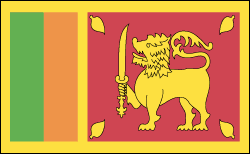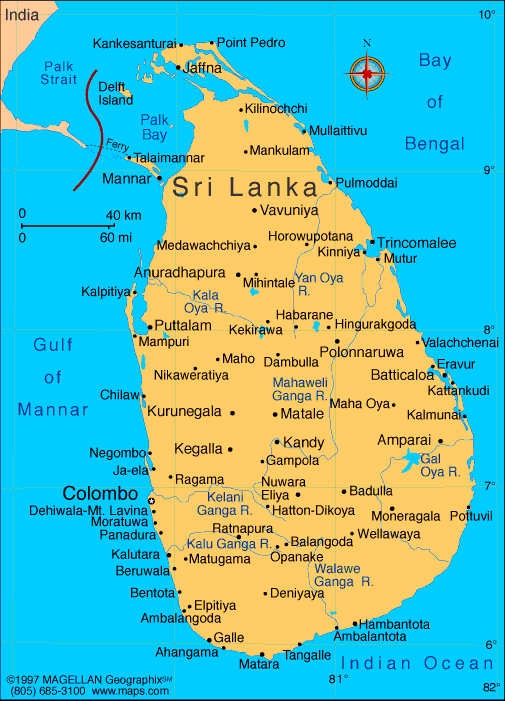SRI LANKA

Geography: An island in the Indian Ocean off the southeast tip of India, Sri Lanka is about half the size of Alabama. Most of the land is flat and rolling; mountains in the south-central region rise to over 8,000 ft (2,438 m).
Government: Republic.
History: Indo-Aryan emigration from India in the 5th century B.C. came to form the largest ethnic group on Sri Lanka today, the Sinhalese. Tamils, the second-largest ethnic group on the island, were originally from the Tamil region of India and emigrated between the 3rd century B.C. and A.D. 1200. Until colonial powers controlled Ceylon (the country's name until 1972), Sinhalese and Tamil rulers fought for dominance over the island. The Tamils, primarily Hindus, claimed the northern section of the island and the Sinhalese, who are predominantly Buddhist, controlled the south. In 1505 the Portuguese took possession of Ceylon until the Dutch India Company usurped control (1658–1796). The British took over in 1796, and Ceylon became an English Crown colony in 1802. The British developed coffee, tea, and rubber plantations. On Feb. 4, 1948, after pressure from Ceylonese nationalist leaders (which briefly unified the Tamil and Sinhalese), Ceylon became a self-governing dominion of the Commonwealth of Nations.
S.W.R.D. Bandaranaike became prime minister in 1956 and championed Sinhalese nationalism, making Sinhala the country's only official language and including state support of Buddhism, further marginalizing the Tamil minority. He was assassinated in 1959 by a Buddhist monk. His widow, Sirimavo Bandaranaike, became the world's first female prime minister in 1960. The name Ceylon was changed to Sri Lanka (“resplendent island”) on May 22, 1972.
The Tamil minority's mounting resentment toward the Sinhalese majority's monopoly on political and economic power, exacerbated by cultural and religious differences, erupted in bloody violence in 1983. Tamil rebel groups, the strongest of which were the Liberation Tigers of Tamil Eelam, or Tamil Tigers, began a civil war to fight for separate nation.
President Ranasinghe Premadasa was assassinated at a May Day political rally in 1993, when a Tamil rebel detonated explosives strapped to himself. Tamil extremists have frequently resorted to terrorist attacks against civilians. The next president, Chandrika Kumaratunga, vowed to restore peace to the country. In Dec. 1999, she was herself wounded in a terrorist attack. By early 2000, 18 years of war had claimed the lives of more than 64,000, mostly civilians.
Government: Republic.
History: Indo-Aryan emigration from India in the 5th century B.C. came to form the largest ethnic group on Sri Lanka today, the Sinhalese. Tamils, the second-largest ethnic group on the island, were originally from the Tamil region of India and emigrated between the 3rd century B.C. and A.D. 1200. Until colonial powers controlled Ceylon (the country's name until 1972), Sinhalese and Tamil rulers fought for dominance over the island. The Tamils, primarily Hindus, claimed the northern section of the island and the Sinhalese, who are predominantly Buddhist, controlled the south. In 1505 the Portuguese took possession of Ceylon until the Dutch India Company usurped control (1658–1796). The British took over in 1796, and Ceylon became an English Crown colony in 1802. The British developed coffee, tea, and rubber plantations. On Feb. 4, 1948, after pressure from Ceylonese nationalist leaders (which briefly unified the Tamil and Sinhalese), Ceylon became a self-governing dominion of the Commonwealth of Nations.
S.W.R.D. Bandaranaike became prime minister in 1956 and championed Sinhalese nationalism, making Sinhala the country's only official language and including state support of Buddhism, further marginalizing the Tamil minority. He was assassinated in 1959 by a Buddhist monk. His widow, Sirimavo Bandaranaike, became the world's first female prime minister in 1960. The name Ceylon was changed to Sri Lanka (“resplendent island”) on May 22, 1972.
The Tamil minority's mounting resentment toward the Sinhalese majority's monopoly on political and economic power, exacerbated by cultural and religious differences, erupted in bloody violence in 1983. Tamil rebel groups, the strongest of which were the Liberation Tigers of Tamil Eelam, or Tamil Tigers, began a civil war to fight for separate nation.
President Ranasinghe Premadasa was assassinated at a May Day political rally in 1993, when a Tamil rebel detonated explosives strapped to himself. Tamil extremists have frequently resorted to terrorist attacks against civilians. The next president, Chandrika Kumaratunga, vowed to restore peace to the country. In Dec. 1999, she was herself wounded in a terrorist attack. By early 2000, 18 years of war had claimed the lives of more than 64,000, mostly civilians.

Map of Sri
Lanka
President: Maithripala Sirisena (2015)
Prime Minister: Ranil Wickremesinghe (2015)
Land area: 24,996 sq mi (64,740 sq km);
total area: 25,332 sq mi (65,610 sq km)
Population (2014 est.): 21,866,445
(growth rate: 0.86%); birth rate: 16.24/1000; infant mortality rate:
9.47/1000; life expectancy: 76.35; density per sq mi: 836.6
Capital and largest city (2011 est.):
Colombo, 693,000. Legislative and judicial capital: Sri
Jayawardenepura Kotte, 126,000
Other large cities: Dehiwala-Mount
Lavinia 245,974; Moratuwa, 207,755; Negombo, 127,754
Monetary unit: Sri Lanka rupee
Languages:
Sinhala 74% (official and national), Tamil 18%
(national), other 8%; English is commonly used in government and
spoken competently by about 10%
Ethnicity/race:
Sinhalese 73.8%, Sri Lankan Moors 7.2%, Indian
Tamil 4.6%, Sri Lankan Tamil 3.9%, other 0.5%, unspecified 10%
(2001)
Religions:
Buddhist 69.1%, Islam 7.6%, Hindu 7.1%, Christian 6.2%, unspecified 10% (2001)
Literacy rate: 91.2% (2010 est.)
Economic summary: GDP/PPP (2013
est.): $134.5 billion; per capita $6,500. Real growth rate:
6.3%. Inflation: 4.7%. Unemployment: 5.1%.
Arable land: 18.29%. Agriculture: rice, sugarcane, grains, pulses, oilseed, spices, vegetables, fruit, tea, rubber, coconuts; milk, eggs, hides, beef; fish. Labor force: 8.528 million (2013 est.); services 42.4%,
agriculture 31.8%, industry 25.8% (2012 est.). Industries:
processing of rubber, tea, coconuts, tobacco and other agricultural
commodities; telecommunications, insurance, banking; tourism, shipping;
clothing, textiles; cement, petroleum refining, information technology
services, construction. Natural resources:
limestone, graphite, mineral sands, gems, phosphates, clay,
hydropower. Exports: $10.39 billion (2013 est.):
textiles and apparel, tea and spices; rubber manufactures; precious stones; coconut products, fish. Imports:
$18
billion (2013 est.): petroleum, textiles, machinery and
transportation equipment, building materials, mineral products,
foodstuffs.
Major trading partners: U.S., UK, India, Germany, Singapore, UAE,
China, Iran, Malaysia, Italy, Belgium (2012).
Communications: Telephones: main lines
in use: 2.796 million (2013); mobile cellular: 19.533 million (2013). Radio
broadcast stations: 50 (2012).
Radios: 3.85 million (1997). Television broadcast
stations: 35 (2012). Televisions: 1.53 million (1997).
Internet Service Providers (ISPs): 9,552 (2012). Internet
users: 1.777 million (2009).
Transportation: Railways: total: 1,449
km (2007). Highways: total: 114,093 km; paved: 16,977 km;
unpaved: 97,116 km (2010). Waterways: 160 km; navigable by
shallow-draft craft (2012). Ports and harbors: Colombo, Galle,
Jaffna, Trincomalee. Airports: 19 (2013).
International disputes: none.
Member of Commonwealth of Nations
-------------------- o --------------------
No comments:
Post a Comment